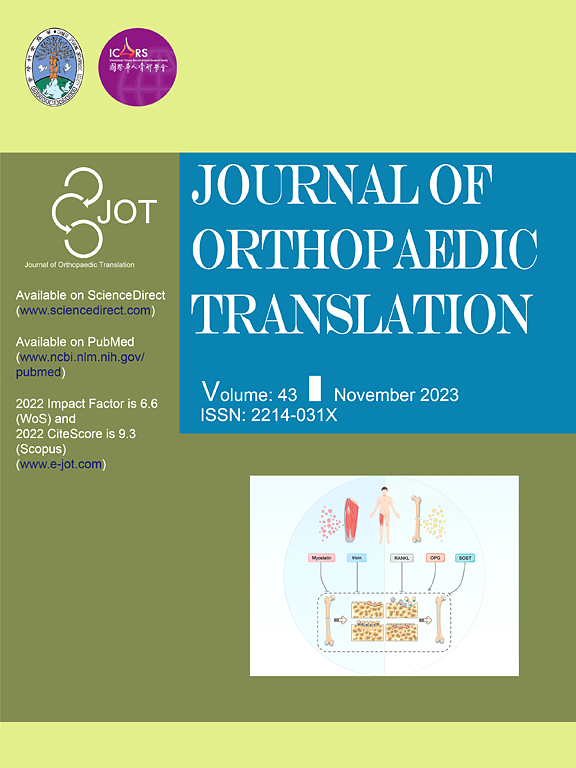依达拉奉对骨关节炎的治疗作用:针对NRF2信号和线粒体功能
IF 5.9
1区 医学
Q1 ORTHOPEDICS
引用次数: 0
摘要
骨关节炎(OA)是最常见的关节炎形式,作为一种慢性健康状况迅速出现,是导致残疾和重大社会经济负担的主要原因。尽管它很普遍,但有效的治疗方法仍然难以捉摸。本研究旨在探讨依达拉奉(edaravone, fda批准的自由基清除剂)在OA发展中的治疗潜力,并阐明其潜在机制。方法采用t-丁基过氧化氢(TBHP)刺激软骨细胞诱导体外氧化应激模型;然后,我们研究了EDA对tbhp处理的软骨细胞的软骨功能障碍、凋亡、炎症反应和线粒体功能的影响及其潜在机制。在体内,采用内侧半月板(DMM)模型的不稳定性来研究EDA对OA进展的影响。应用Nrf2 - / -小鼠来确定Nrf2作为EDA靶点的潜在作用。结果tseda可显著缓解氧化应激引起的软骨细胞功能障碍,保护软骨细胞免于凋亡和炎症反应,维持软骨细胞内线粒体功能和氧化还原平衡。在分子水平上,EDA似乎通过参与和激活核因子红细胞2相关因子2 (NRF2)途径来阻止OA的进展,NRF2对于维持线粒体功能和氧化还原平衡至关重要。值得注意的是,在Nrf2−/−小鼠中,EDA对OA的保护作用被取消,这强调了Nrf2信号通路在介导EDA治疗作用中的重要性。结论eda具有减轻骨性关节炎软骨细胞变性的潜力,从而减缓骨性关节炎的进展。因此,EDA可能代表一种新的治疗OA的药物,潜在地扩大其临床应用。作为一种临床许可的用于治疗神经系统疾病的药物,依达拉奉在OA发展中显示出良好的治疗效果。机制上,依达拉奉通过激活NRF2信号通路稳定线粒体功能,维持氧化还原稳态。体内外实验验证了依达拉奉对OA的保护作用。这些发现为依达拉奉在临床治疗OA提供了强有力的证据。本文章由计算机程序翻译,如有差异,请以英文原文为准。

Therapeutic effect of edaravone on osteoarthritis: targeting NRF2 signaling and mitochondrial function
Background
Osteoarthritis (OA), the most prevalent form of arthritis, is swiftly emerging as a chronic health condition, that poses the primary cause of disability and significant socioeconomic burden. Despite its prevalence, effective therapeutic options for OA remain elusive. This study seeks to explore the therapeutic potential of edaravone (EDA), a FDA-approved free radical scavenger, in the context of OA development and to elucidate its underlying mechanisms.
Methods
In vitro, oxidative stress models were induced by stimulating chondrocytes with t-butylhydroperoxide (TBHP); then, we investigated the influence of EDA on chondrocyte dysfunction, apoptosis, inflammatory responses and mitochondrial function in TBHP-treated chondrocytes, along with the underlying mechanisms. In vivo, destabilization of the medial meniscus (DMM) model was used to investigate the impact of EDA on OA progression. Nrf2−/− mice were applied to determine the potential role of NRF2 as a target for EDA.
Results
EDA notably alleviates chondrocyte dysfunction triggered by oxidative stress, safeguards chondrocytes from apoptosis and inflammatory responses, and preserves mitochondrial function and redox balance within chondrocytes. At the molecular level, EDA appears to halt the progression of OA by engaging and activating the nuclear factor erythroid 2-related factor 2 (NRF2) pathway, which is crucial for maintaining mitochondrial function and redox equilibrium. Notably, the protective effects of EDA on OA are abolished in Nrf2−/− mice, underscoring the significance of the NRF2 signaling pathway in mediating EDA's therapeutic effects.
Conclusion
EDA has the potential to mitigate chondrocyte degeneration, thereby slowing the progression of OA. Thus, EDA may represent a novel therapeutic agent for the treatment of OA, potentially expanding its clinical utility.
The translational potential of this article
As a clinically licensed drug used for the treatment of neurological disorders, edaravone has shown promising therapeutic effects on OA development. Mechanistically, edaravone stabilized mitochondrial function and maintained redox homeostasis by activating NRF2 signaling pathway. The protective effects of edaravone against OA were verified in vivo and in vitro. These findings presented robust evidence for repurposing edaravone for the treatment of OA in clinic.
求助全文
通过发布文献求助,成功后即可免费获取论文全文。
去求助
来源期刊

Journal of Orthopaedic Translation
Medicine-Orthopedics and Sports Medicine
CiteScore
11.80
自引率
13.60%
发文量
91
审稿时长
29 days
期刊介绍:
The Journal of Orthopaedic Translation (JOT) is the official peer-reviewed, open access journal of the Chinese Speaking Orthopaedic Society (CSOS) and the International Chinese Musculoskeletal Research Society (ICMRS). It is published quarterly, in January, April, July and October, by Elsevier.
 求助内容:
求助内容: 应助结果提醒方式:
应助结果提醒方式:


